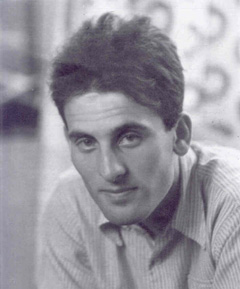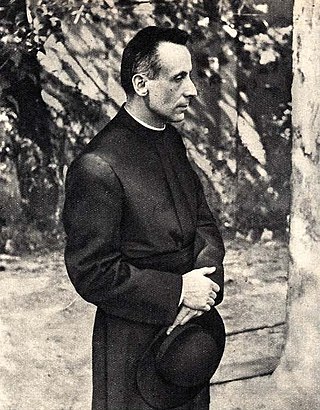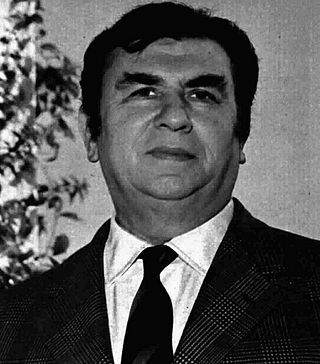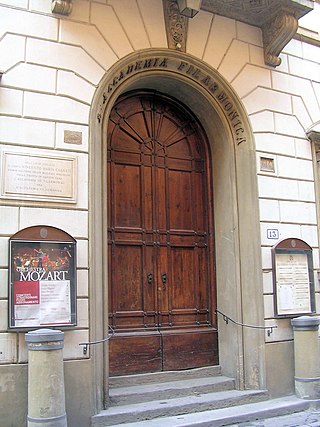Related Research Articles

Giuseppe Vitali was an Italian mathematician who worked in several branches of mathematical analysis. He gives his name to several entities in mathematics, most notably the Vitali set with which he was the first to give an example of a non-measurable subset of real numbers.

Giuseppe Paolo Stanislao "Beppo" Occhialini ForMemRS was an Italian physicist who contributed to the discovery of the pion or pi-meson decay in 1947 with César Lattes and Cecil Frank Powell, the latter winning the Nobel Prize in Physics for this work. At the time of this discovery, they were all working at the H. H. Wills Laboratory of the University of Bristol.

Pier Ferdinando Casini is an Italian politician. He served as President of the Chamber of Deputies from 2001 to 2006.

The Congregation for Catholic Education (Institutes of Study) (Latin: Congregatio de Institutione Catholica (Studiorum Institutis)) was the pontifical congregation of the Roman Curia responsible for: universities, faculties, institutes and higher schools of study, either ecclesial or non-ecclesiastical dependent on ecclesial persons; and schools and educational institutes depending on ecclesiastical authorities.

Giuseppe Dossetti was an Italian jurist, a politician, and from 1958 onward, a Catholic priest.

Giuseppe Maria Crespi, nicknamed Lo Spagnuolo, was an Italian late Baroque painter of the Bolognese School. His eclectic output includes religious paintings and portraits, but he is now most famous for his genre paintings.

The Messa per Rossini is a Requiem Mass composed to commemorate the first anniversary of Gioachino Rossini's death. It was a collaboration among 13 Italian composers, initiated by Giuseppe Verdi. The composition was intended to be performed on 13 November 1869 in the Basilica of San Petronio, Bologna, where Rossini grew up and spent a large part of his life.

Luigi Cervi, better known as Gino Cervi, was an Italian actor. He was best known for portraying Peppone in a series of comedies based on the character Don Camillo (1952-1965), and police detective Jules Maigret on the television series Le inchieste del commissario Maigret (1964-1972).
The School of Ferrara was a group of painters which flourished in the Duchy of Ferrara during the Renaissance. Ferrara was ruled by the Este family, well known for its patronage of the arts. Patronage was extended with the ascent of Ercole d'Este I in 1470, and the family continued in power till Alfonso II, Ercole's great-grandson, died without an heir in 1597. The duchy was then occupied in succession by Papal and Austrian forces. The school evolved styles of painting that appeared to blend influences from Mantua, Venice, Lombardy, Bologna, and Florence.

The Bolognese School of painting, also known as the School of Bologna, flourished between the 16th and 17th centuries in Bologna, which rivalled Florence and Rome as the center of painting in Italy. Its most important representatives include the Carracci family, including Ludovico Carracci and his two cousins, the brothers Agostino and Annibale Carracci. Later, it included other Baroque painters: Domenichino and Lanfranco, active mostly in Rome, eventually Guercino and Guido Reni, and Accademia degli Incamminati in Bologna, which was run by Lodovico Carracci. Certain artistic conventions, which over time became traditionalist, had been developed in Rome during the first decades of the 16th century. As time passed, some artists sought new approaches to their work that no longer reflected only the Roman manner. The Carracci studio sought innovation or invention, seeking new ways to break away from traditional modes of painting while continuing to look for inspiration from their literary contemporaries; the studio formulated a style that was distinguished from the recognized manners of art in their time. This style was seen as both systematic and imitative, borrowing particular motifs from the past Roman schools of art and innovating a modernistic approach.

The Accademia Filarmonica di Bologna is a music education institution in Bologna, Italy.

The Accademia di Belle Arti di Bologna is a public tertiary academy of fine art in Bologna, in Emilia-Romagna in northern Italy. It has a campus in Cesena.

Giacomo Lercaro was an Italian cardinal of the Roman Catholic Church who served as Archbishop of Ravenna from 1947 to 1952, and Archbishop of Bologna from 1952 to 1968. Pope Pius XII made him a cardinal in 1953.

Luigi Federzoni was a twentieth-century Italian nationalist and later Fascist politician.
Alberto Melloni is an Italian church historian and a Unesco Chairholder of the Chair on Religious Pluralism & Peace, primarily known for his work on the Councils and the Second Vatican Council. Since 2020, he is one of the European Commission's Chief Scientific Advisors.

Bologna is a city in and the capital of the Emilia-Romagna region in Northern Italy, of which it is also its largest. It is the seventh most populous city in Italy with about 400,000 inhabitants and 150 different nationalities. Its metropolitan area is home to more than 1,000,000 people. It is known as the Fat City for its rich cuisine, and the Red City for its Spanish-style red tiled rooftops and, more recently, its leftist politics. It is also called the Learned City because it is home to the oldest university in the world.
Romano Volta is an Italian businessman who is the executive chairman and founder of Datalogic, an Italian company manufacturing barcode readers, mobile computers, radio-frequency identification, sensors for detection, and other electronic equipment.
Giuseppe Alberigo was an Italian Catholic historian and editor of a history of the Second Vatican Council that focuses on alleged discontinuities and departures from previous Church teaching.

Crucifixion with Saints or Crucifixion with Mourners and Saints Bernardino of Siena, Francis of Assisi and Petronius is a 1583 oil on canvas, now in the church of Santa Maria della Carità in Bologna. The work was originally sited in the Macchiavelli chapel in San Nicolò di San Felice, Bologna, next to Santa Maria della Carità, which was destroyed by bombing during the Second World War. It was then temporarily moved to the Soprintendenza di Bologna and finally to its current home.
The Dicastery for Culture and Education is an administrative unit of the Roman Curia. It began operations on 5 June 2022 as established by the apostolic constitution Praedicate evangelium promulgated on 19 March 2022. It was formed through the merger of two earlier bodies, the Pontifical Council for Culture and the Congregation for Catholic Education.
References
- 1 2 Allen Jr., John L. (16 January 2022). "Friendship between cardinal and politician cemented comeback of 'Bologna school'". Crux. Retrieved 2022-01-24.